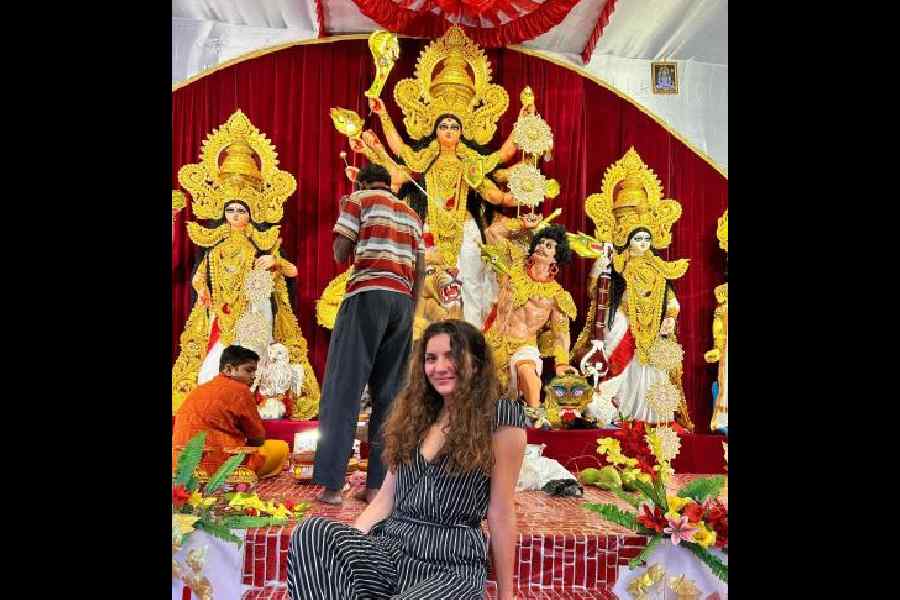As a foreigner experiencing Durga puja for the first time, I felt completely immersed in a world of excellent art, mesmerising themes, and a deep sense of spirituality. My journey into this unique cultural phenomenon began with a set of expectations, nourished by pictures of previous years as well as comments of locals who insisted that “this is the best time of the year to be here,” a time when the entire city turns into an open-air exhibition of creativity, wonder, and devotion.
I had been told that the pandals were more than just temporary structures; they are living pieces of art telling stories. In fact, one of the most charming aspects of Durga puja is the way it seamlessly blends tradition and modernity, faith and enjoyment.
As I began my pandal-hopping adventure, I quickly realised that Durga puja was more than just an aesthetic spectacle. It is a way to dive into Calcutta’s rich culture and the spiritual depth of its people. I did not look at the pandals as artistic expressions only, but also as vehicles for social messages and contemporary issues. For sure, I was expecting beauty, but I had also found art with a purpose. While the artistry of the pandals is undoubtedly captivating, it is the deep sense of joy and unity that left a lasting impression on me. The non-stop liveliness of Calcutta, the sounds of dhak and conch shells coming from the crowded streets, and the sweet fragrance of incense and flowers in the air were unmissable.
As a graduate student of migration and intercultural relations, I strongly believe that cultural and artistic expressions are catalysts for social change. And so are the pandals; they act as powerful mediums for discussion, addressing topics like climate change, gender equality, history, and societal and political problems. It is extremely fascinating to notice how Durga puja serves as a catalyst for raising awareness and sparking conversations about important social contemporary issues.

FD Block pandal, AE (Part 1)
The pandal in AE (Part 1), that showed Alipur Central Jail, was one of the most touching ones. Absolutely well-made, it managed to convey the struggle of the freedom-fighters.
At the beautiful pandal in FD Block, from the colours and lights to the style and idols, no detail was left to chance. It was outside this pandal that I tried a paan for the first time. Such an explosion of flavours it was!
Talking of streetfood, on the first day of the Puja I also tried the phuchka. I was scared it would be spicy since Italian cuisine, which we are used to, tastes so different. But it was not! The next day, I visited a pandal in Behala which was on phuchkas.
I come from Aprilia, a small city in central Italy, where artistic local expressions and cultural preservation are hardly promoted. Yet, as my father is a framer of paintings and photographs, I have always been surrounded by art and I have learned how to appreciate it since I was a child.
This is what made me follow all the behind-the-scenes work at the pandals. It was fascinating to observe artists painting the idols and work on the pandals which were yet to be completed. Thanks to this festival, skilled artisans and craftsmen are given the opportunity to showcase their talent in front of visitors and provided a platform to display their work, gain recognition, and get economic opportunities. This, in turn, supports the growth and preservation of traditional arts and crafts, contributing to cultural exchanges and international awareness.
Being thrown into the world of Durga puja worked for me as a spiritual and cultural awakening that has far surpassed my expectations. The grandeur and artistry of the pandals were absolutely breathtaking. However, it was the soul of the festivity, the unity, the inclusivity, as well as the good energy spread in the air that left a lasting impression.
Although I have tried to share my impressions, Durga Puja is such a difficult experience to describe. I’d say it is easier to travel to Calcutta and enjoy the experience both by day and night. I will soon leave the city with a heart full of gratitude for having been a part of this extraordinary celebration, through which I could discover the joyful soul of the City of Joy.
Francesca Panico is an Erasmus Mundus scholar in migration and intercultural relations from Oldenburg University, Germany. Originally from Italy, she is currently on exchange at Rabindra Bharati University, affiliated with Calcutta Research Group Institute, and is a resident of BE Block.
